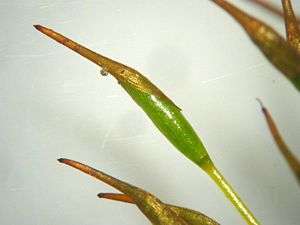Calyptra
Calyptra (from καλύπτρα (kalúptra) "veil") is a scientific term used in botany. It describes a feature in plant morphology.

Calyptra of tortula moss Tortula muralis
Calyptra on top of the brown spore capsule (sporophyte) of the moss Physcomitrella patens. The brownish archegonial venter is still visible.
Bryophytes
In bryophytes, the calyptra (plural calyptrae) is an enlarged archegonial venter that protects the capsule containing the embryonic sporophyte.[1] The calyptra is usually lost before the spores are released from the capsule. The shape of the calyptra can be used for identification purposes.[2]
Flowering plants
In flowering plants, the calyptra is a covering tissue for stamens and carpels. The name is also used for the capping tissue of roots, the root cap.
References
- ↑ Ralf Reski (1998): Development, genetics and molecular biology of mosses. In: Botanica Acta. 111, 1-15.
- ↑ Malcolm; Malcolm, Bill; Nancy (2006), Mosses and other Bryophytes, an Illustrated Glossary, Micro-Optics Press, p. 65, ISBN 0-9582224-7-9
External links

This article is issued from
Wikipedia.
The text is licensed under Creative Commons - Attribution - Sharealike.
Additional terms may apply for the media files.